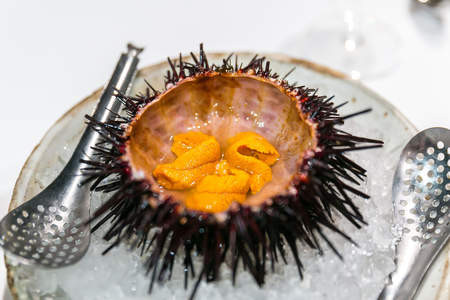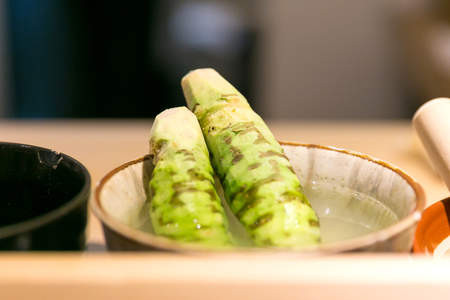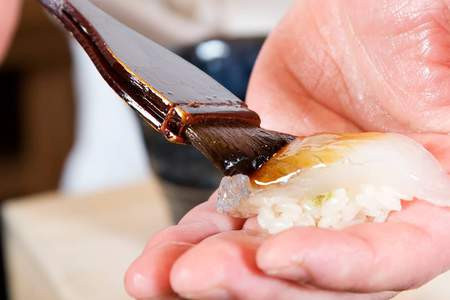Omakase is more than just a meal; it’s a unique and intimate Japanese dining experience. In this traditional style, you entrust yourself to the chef, allowing them to curate a personalized menu based on the freshest ingredients, your preferences, and the chef’s culinary expertise. Often compared to a Western tasting menu, omakase transcends a simple sequence of dishes. It’s a dynamic interaction, a silent and spoken dialogue between you and the chef, built on mutual respect and culinary exploration.
The term “omakase” itself comes from the Japanese phrase “omakase shimasu,” which translates to “I trust you, chef.” This inherent trust is the cornerstone of the omakase experience. As a diner, you embrace openness to new flavors and preparations, while also communicating any dietary restrictions or dislikes. This collaboration ensures a dining journey that is both surprising and perfectly tailored to your palate.
While omakase is most famously associated with exquisite sushi, the culinary journey can extend beyond raw fish. Expect to encounter a variety of dishes, from delicate salads and crisp tempura to comforting soups, all reflecting the season’s best offerings and the chef’s creative vision.
What to Anticipate During Your Omakase Serving
Your omakase adventure typically unfolds at the sushi counter, positioning you face-to-face with the sushi chef. This setting is crucial, fostering direct interaction and immediate service. Upon seating, the chef will greet you, perhaps with a welcoming joke, setting a personalized tone for the evening. You’ll observe them meticulously preparing their workspace and crafting the initial appetizers. A hallmark of an omakase chef is their constant engagement – hands always in motion, focused on their art, yet attentively present for conversation with you.
You might be offered a warm towel for hand cleansing, a subtle gesture of Japanese hospitality. While formal napkin placement isn’t always emphasized, the focus remains on your comfort and enjoyment. Chopsticks are usually provided for sashimi and non-sushi courses, but when it comes to sushi in an omakase setting, feel encouraged to use your hands. This is not only acceptable but often preferred, allowing you to fully appreciate the texture and temperature of the perfectly crafted sushi. Of course, if you prefer chopsticks, they are always readily available. The essence of Omakase Serving is to prioritize the diner’s optimal experience.
Before the culinary journey truly begins, it’s crucial to inform the chef of any allergies or dietary preferences. Clear communication is key. Phrases like, “I have a shellfish allergy,” or “I prefer milder fish but am open to trying mackerel,” are helpful in guiding the chef and ensuring your safety and satisfaction.
Often, an introductory dish precedes the sushi courses. While miso soup is a common starter in Americanized Japanese restaurants, it’s traditionally served at the meal’s conclusion in Japan. Instead, anticipate a lighter, often chilled dish to begin your omakase serving. This could be a silken tofu preparation or a refreshing salad featuring delicate raw white fish, designed to awaken your palate.
 Close-up of uni (sea urchin) on ice.
Close-up of uni (sea urchin) on ice.
A fresh serving of Uni (sea urchin) presented on ice, highlighting the quality and delicacy of omakase ingredients.
As the sushi serving commences, each piece is prepared and presented to you individually, at the ideal temperature and seasoning. In omakase etiquette, it’s considered best to enjoy each piece promptly. While waiting for companions might be customary in other dining settings, in omakase, immediate consumption allows you to experience the sushi at its peak freshness, as intended by the chef. Don’t be surprised if the chef observes you as you savor each bite. This is a crucial aspect of the omakase experience. The chef subtly gauges your reactions, interpreting facial expressions and verbal cues to understand your preferences and adjust the subsequent servings accordingly. Don’t hesitate to voice your thoughts – a comment like, “That was saltier than I expected!” is valuable feedback for the chef and part of the interactive nature of omakase serving.
The traditional progression of omakase serving often starts with milder-flavored fish like sayori (needlefish) and hirame (flounder), gradually transitioning to richer, more intense flavors like otoro (fatty tuna belly). This is a general guideline, and contemporary omakase experiences may deviate. Some avant-garde establishments might even begin with toro, showcasing the chef’s unique style and challenging conventional omakase serving sequences.
After a series of courses, ranging from eight to over twenty pieces, the chef will signal the nearing conclusion of your omakase serving. Dessert is not a standard component of traditional edomae omakase, but some modern restaurants may offer a sweet ending, such as Shuko in NYC, known for their apple pie. Traditional omakase often concludes with one of the following:
- Maki, such as tekka maki (tuna roll)
- A hand roll, like temaki
- Tamago (sweet egg omelet)
The appearance of any of these signals the final stages of your meal. The chef will express their gratitude, and then discreetly begin tidying their workspace, allowing you to settle your bill in a relaxed atmosphere.
The Cost of Omakase Serving
It’s important to understand that omakase is not simply a budget sushi option. It represents the chef’s highest level of culinary offering, reflecting premium ingredients, exceptional skill, and a personalized dining experience. You can expect the base price for omakase to start around $50, but many omakase experiences are priced closer to $100 or even higher, depending on the restaurant’s prestige, ingredients, and the complexity of the courses. The cost reflects not only the quality of food but also the dedicated time and expertise of the chef in crafting a bespoke meal for each guest.
Tipping Etiquette in Omakase Restaurants
Tipping customs vary significantly between Japan and the West. In Japan, tipping is not customary and can even be perceived as impolite. Therefore, if you are dining at an authentic Japanese sushiya, especially in Japan, there is no expectation to leave a monetary tip. However, in America, tipping is generally expected in restaurants. Interestingly, a growing trend, particularly in high-end sushiya, is the adoption of a no-tipping policy. Restaurants that operate without tips will typically communicate this policy clearly. Omakase serving embodies exceptional service, delivered by highly skilled professionals with extensive experience. If tipping is customary, any gratuity you offer should acknowledge this elevated level of service and expertise.
Ultimately, beyond any monetary tip, expressing sincere courtesy, respect, and appreciation towards the chef and staff will be deeply valued and contribute to the overall positive omakase experience.
Preparing for Your Omakase Serving
For those who prefer spontaneity, walking into an omakase experience with an open mind can be incredibly rewarding. However, if you wish to maximize your enjoyment and understanding, some preparation can be beneficial. Familiarizing yourself with different types of fish and understanding your own palate preferences can enhance your appreciation. Exploring the broad categories of fish you might encounter can be a helpful starting point:
- Fatty Fish: Examples include toro (fatty tuna), hamachi (yellowtail), and salmon.
- White Fish: Generally milder in flavor, such as hirame (flounder).
- Fish Eggs: Like ikura (salmon roe).
- Strongly Flavored Shellfish: Such as uni (sea urchin).
- Chewy Fish and Shellfish: Including ika (squid), tako (octopus), and mirugai (giant clam).
- Cooked Eel: Such as unagi (freshwater eel) and anago (saltwater eel).
- Pickled Strong Fish: Like iwashi (sardine) and saba (mackerel).
 Assortment of Japanese ingredients including wasabi root.
Assortment of Japanese ingredients including wasabi root.
A selection of premium Japanese ingredients, potentially used in omakase serving, featuring fresh wasabi root.
If you consider yourself a less adventurous eater, it might be helpful to research common omakase offerings and identify fish types you are comfortable with.
Another aspect to consider is your hunger level before your omakase serving. The number of courses can vary significantly between restaurants. An omakase with 8-10 pieces is considered a lighter meal, while a 20-piece experience is quite substantial and will likely leave you feeling very full, even if you arrive with a hearty appetite. Online reviews, especially on platforms like Yelp, can provide insights into the typical portion sizes at different omakase restaurants, helping you plan accordingly.
Buyer Beware: Recognizing Authentic Omakase
The surge in sushi’s popularity has, unfortunately, led to some misrepresentation of the omakase tradition. Some establishments may use “omakase” as a mere marketing term without delivering the true essence of the experience. To ensure you are getting an authentic omakase serving, be mindful of a crucial indicator:
If you are not in direct communication with the chef at the sushi bar, it is likely not a genuine omakase experience!
True omakase is defined by the personal interaction, the chef’s direct service, and the tailored culinary journey crafted specifically for you. It’s this intimate and trusting relationship that distinguishes a genuine omakase serving from a standard tasting menu.
Ψ
Related Ingredients and Recipes
 Close-up of Yuzu fruit. Yuzu, ユズ (Japanese Lemon)
Close-up of Yuzu fruit. Yuzu, ユズ (Japanese Lemon)
 Nikiri sauce being brushed on sushi. Nikiri Recipe (Brush-on Sweet Soy Sauce)
Nikiri sauce being brushed on sushi. Nikiri Recipe (Brush-on Sweet Soy Sauce)
Get Sushi Insights Delivered to Your Inbox!
Subscribe to our bi-monthly newsletter for sushi recipes, tutorials, and industry news.
